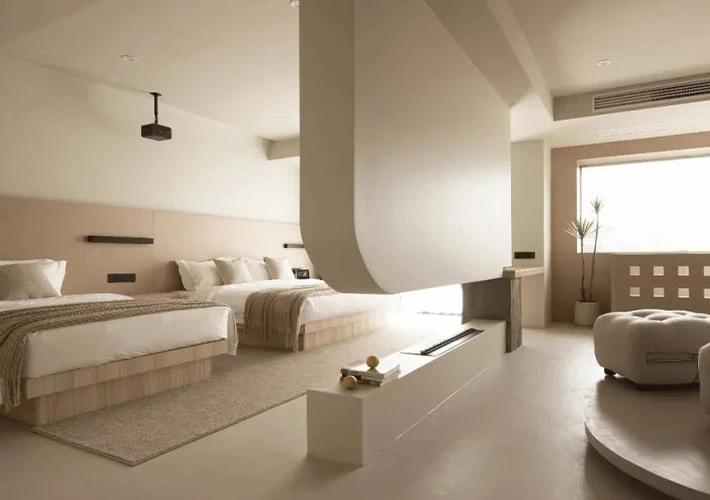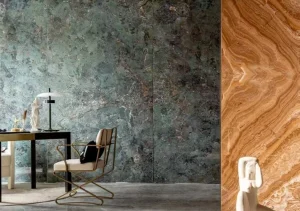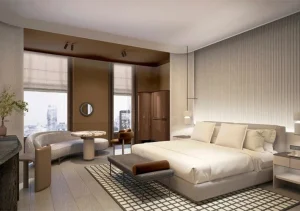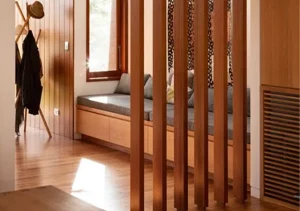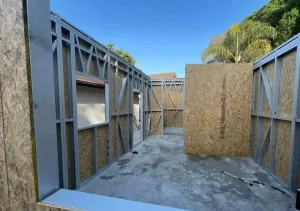Table of Contents
ToggleIntroduction
In today’s hospitality industry, travelers are increasingly searching for hotel accommodations that go beyond the traditional single-room setup. Families, business travelers, and long-stay guests demand more space, flexibility, and comfort during their stay. Hotels with 2 bedroom suites have emerged as a practical and desirable solution, offering privacy for multiple guests while also providing shared living spaces that create a “home away from home” experience.
These suites are more than just larger hotel rooms—they represent a thoughtful balance of comfort, functionality, and design efficiency. In this guide, we will explore why hotels with 2 bedroom suites are in high demand, the essential design principles that make them successful, layout options, key features, design styles, and market trends.
Why Hotels with 2 Bedroom Suites Are in High Demand
Families and Group Travelers
For families with children, 2 bedroom suites are a game changer. Instead of booking two separate rooms, families can stay together in one suite while still maintaining privacy between parents and children. Similarly, groups of friends traveling together prefer suites where they can share costs while enjoying private bedrooms and common spaces.
Corporate and Long-Stay Guests
Business travelers often travel in pairs or teams. A 2 bedroom suite allows them to share accommodation costs without sacrificing privacy. Extended-stay guests, such as digital nomads or relocating professionals, also value suites with extra bedrooms, kitchens, and living areas because they replicate the feel of an apartment.
Competitive Advantages for Hoteliers
Hotels offering 2 bedroom suites differentiate themselves from competitors. Suites can be marketed as:
- Family-friendly accommodations near theme parks or resorts.
- Executive or corporate suites in business districts.
- Luxury retreats in resorts or boutique hotels.
This versatility helps hotels appeal to broader traveler segments and increase booking rates.
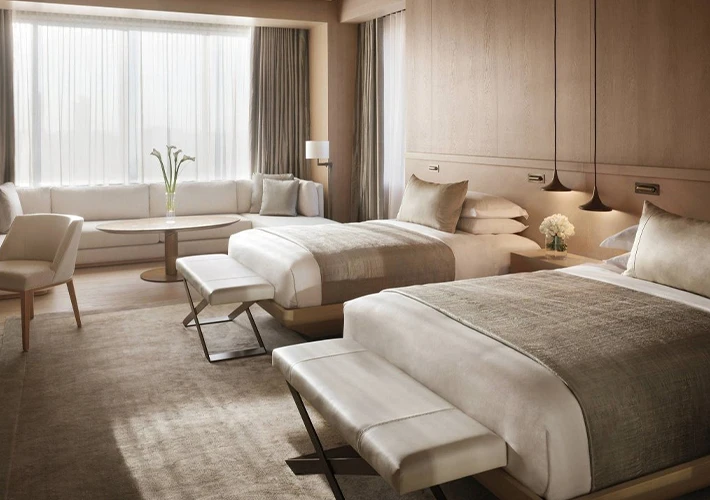
Essential Design Principles for 2 Bedroom Hotel Suites
Space Optimization
Space is the foundation of a successful 2 bedroom suite. A typical size ranges from 700 to 1,200 square feet depending on the hotel category. Designers should maximize usable areas while ensuring the suite feels open and inviting. Efficient layouts prevent wasted corridors and optimize space for living and sleeping.
Privacy Considerations
Privacy is one of the top reasons guests choose 2 bedroom suites. To achieve this, designers should:
- Place bedrooms at opposite ends of the suite.
- Install solid partitions and soundproof doors.
- Include individual en-suite bathrooms whenever possible.
Flexible Layouts
Hotels should design suites that serve different types of travelers:
- Families: A master bedroom plus a twin bedroom.
- Business travelers: Two equally sized bedrooms with separate desks.
- Luxury travelers: A large master suite with a walk-in closet plus a smaller guest bedroom.
Functional Layout Options for 2 Bedroom Suites
Classic Layout
The classic design places a living room between two bedrooms. This setup encourages social interaction and is perfect for families or groups who value communal space.
Split Suite Layout
In this design, bedrooms are positioned at opposite ends of the suite with living spaces in the middle. It maximizes privacy, making it ideal for business travelers or unrelated guests sharing accommodation.
Duplex or Loft Layout
Multi-level suites create a luxurious feel. Bedrooms may be placed upstairs, while the lower level serves as the communal area with living, dining, and kitchen spaces. This design is popular in resorts and upscale urban hotels.
Hybrid Layout
A hybrid combines open-plan concepts with private elements. For example, a central lounge connects two bedrooms but includes sliding doors for privacy. Hybrid layouts are flexible, catering to both families and corporate travelers.
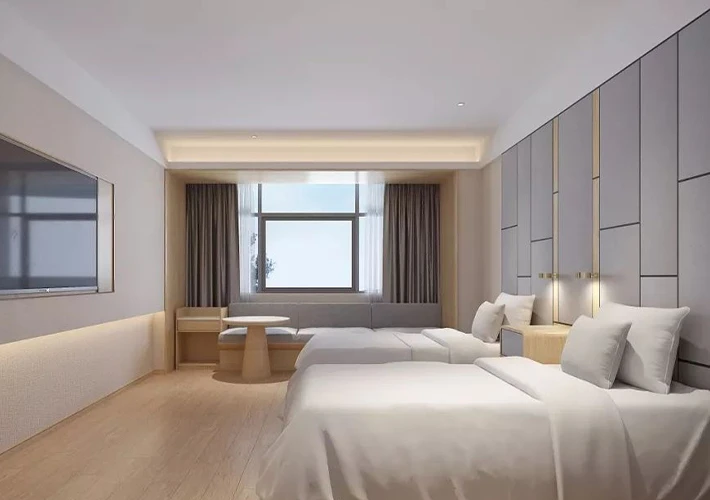
Key Features That Enhance Comfort & Functionality
Living Room as the Central Hub
The living room should serve as the heart of the suite. Features may include:
- Comfortable sofas and armchairs.
- A large smart TV with streaming options.
- A multi-purpose work desk for business travelers.
Bedroom Designs and Bedding Options
Bedrooms should prioritize comfort and customization:
- Premium mattresses and high-quality bedding.
- Adjustable bedside lighting.
- Wardrobes or walk-in closets.
- Flexible setups such as king, queen, or twin beds.
Bathrooms and En-Suite Advantages
Two bedroom suites often include at least two bathrooms, which improves functionality. The master bathroom can feature luxury amenities such as double vanities, a soaking tub, or a walk-in shower. Guest bathrooms may be smaller but should still provide high-quality finishes.
Kitchen/Kitchenette and Dining Space
A growing trend in hotel design is including kitchen facilities. Even a compact kitchenette with a microwave, refrigerator, and sink adds tremendous value. For long-stay travelers, a full kitchen enables self-catering. Adjacent dining areas with tables and chairs allow families to share meals in comfort.
Design Styles and Aesthetic Approaches
Modern Minimalist
This design favors clean lines, neutral tones, and open spaces. It appeals to business travelers and urban guests who prefer simplicity and sophistication.
Contemporary Luxury
Premium finishes such as marble countertops, leather seating, and designer lighting define this style. Larger suites may feature floor-to-ceiling windows with panoramic views.
Family-Friendly Design
Family suites prioritize safety, comfort, and durability. Softer color palettes, child-friendly furniture, and sofa beds for additional sleeping space are common features.
Resort-Style Design
At resorts, suites often include balconies, terraces, or private plunge pools. Natural materials like wood and stone connect indoor and outdoor spaces, enhancing relaxation.

Market Trends and Business Benefits for Hoteliers
Rising Demand for Extended Stays
The extended-stay market is booming, especially in metropolitan cities. Guests staying weeks or months seek suites that feel like apartments. 2 bedroom suites with kitchens and workspaces cater perfectly to this demand.
Post-Pandemic Shift Toward Privacy
Travelers are more conscious of shared spaces. Suites allow guests to minimize interaction with public hotel facilities by offering private dining and lounging areas.
Luxury and Boutique Suite Growth
Boutique hotels increasingly feature unique 2 bedroom suites to attract high-end travelers. These suites often emphasize exclusivity, offering personalized interiors and premium services.
Revenue and Brand Loyalty Advantages
From a business perspective:
- Higher Average Daily Rate (ADR): Suites can earn 30–60% more than standard rooms.
- Improved Occupancy Rates: Larger groups book suites instead of multiple rooms.
- Brand Loyalty: Families and business travelers who enjoy suite stays are more likely to return.
- Upselling Potential: Guests in suites are more likely to purchase premium services such as in-room dining, spa treatments, or concierge experiences.
Conclusion
Hotels with 2 bedroom suites represent a growing trend in hospitality that balances comfort, functionality, and profitability. From families seeking shared yet private spaces to business travelers needing efficiency, these suites meet diverse traveler expectations.
By focusing on smart layouts, privacy, thoughtful features, and appealing design styles, hoteliers can transform suites into powerful revenue drivers. The market trends clearly show that demand will continue to grow, especially among extended-stay travelers and families.
For hotels, investing in well-designed 2 bedroom suites is not just about adding larger rooms—it’s about creating memorable experiences that drive loyalty and set the property apart in a competitive market.


